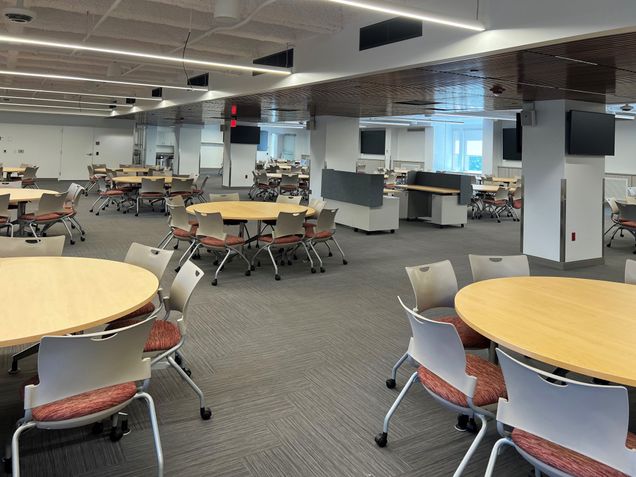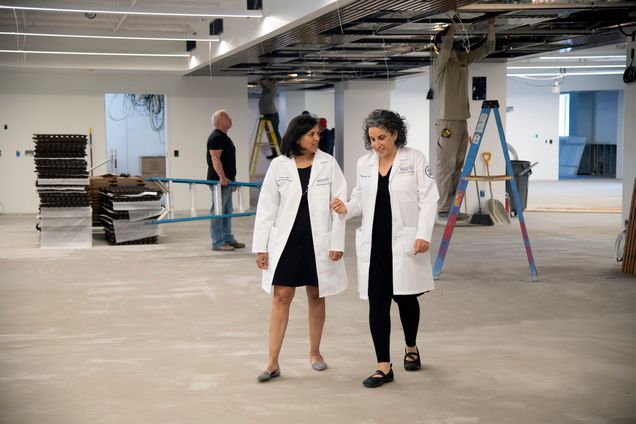New Curriculum Will Drive Patient-Centered, Equitable Care
 The new Learning Center is central for the collaborative, team-based approach that is more in line with how students study today.
The new Learning Center is central for the collaborative, team-based approach that is more in line with how students study today.
When Priya Garg, MD, became BUSM associate dean for medical education in 2017, feedback from student focus groups included requests for flexibility in how they learn and for designated curriculum time to explore the societal and healthcare issues that brought them to the School. At the same time, faculty were concerned that lectures were sparsely attended, leading them to believe that most students were learning outside the classroom.
This feedback helped guide a newly designed medical education curriculum that will be fully implemented for the entering MD class of 2022. The goal is to graduate “doctors who can provide patient-centered, equitable care, who have a solid knowledge base and a strong ability to clinically reason,” said Molly Cohen-Osher, MD, MMedEd, assistant dean for medical education for curriculum and instructional design.
Broadly speaking, curriculum is what gets taught to students, but also applies to what they are able to learn, understand and retain, explained Cohen-Osher.
The teaching model that has dominated medical education for over a century consists of two years learning the science underpinning diagnosis and care, followed by two years of clinical rotations. Medical students typically spend their first year understanding how the systems in the body work; in the second year, they focus on what can go wrong. The new curriculum merges the two using multiple teaching methodologies and formats that focus on active rather than passive learning.
The hallmarks of the new approach include the expansion of clinical case work and cases that apply knowledge into all four years; an emphasis on team-based and self-directed learning; and the integration of content across foundational, clinical and social science with a focus on health equity.
The Bigger Picture: The Role of Health Equity
Before she came to BUSM, Garg often heard her husband Arvin Garg, MD (MED’99) say that students chose the school for its mission of training future leaders and advocates addressing health care disparities.
“Many students come to medical school focused on learning as much science as they can and believe that knowledge is what will make them a great physician. But all of us who take care of patients know that science is actually only one piece of what you need to provide exemplary care,” said Garg, who is leading the curriculum change initiative with Dean Karen Antman, MD.
Health equity will be fully integrated into the new curriculum in all the courses, with seven weeks of dedicated classroom instruction in the first two years. Cheryl McSweeney, MD, assistant professor of family medicine, directs the new health equity course. Known by the acronym LEADS (Learn, Experience, Advocate, Discover, Serve), the classes encompass subjects focused on the health impacts of societal factors like racism, the refugee population, immigrant and global health, homelessness, addiction and LGBTQ+ communities. Additional skill development in areas such as advocacy and research, narrative medicine and public health knowledge will be included.
“So little of what actually contributes to health for people happens in that one-on-one visit that we’re training everybody for. It’s much broader than that,” said McSweeney, director of the first-year course, Essentials of Public Health. “We need students to understand the physiology and to know what’s the best evidence for the treatment of patients in terms of medication, but you also have to have an understanding that it’s not going to work if they don’t have the refrigerator to store that medication.”
Along with broadening student perspectives on health care, another curriculum goal was to improve understanding and retention of what was being taught. Garg recalls that when she first came to BUSM, faculty expressed their concern that they weren’t interacting with students and that few were coming to their classes but rather, viewing recordings of the lectures. This has been a trend in medical schools nationwide for years.
“Even the chairs began to notice and asked me why we didn’t require students to come to class,” she said. “My response has always been that we have to make the classroom experience meaningful if we want students to be required to attend.”
First-year medical student Sherry Ershadi chose BUSM because the program allowed first-year students access to Boston Medical Center to give them real-life experience.
“Integrating those cases into team-based-learning sessions or into Doctoring [another first-year course] definitely helps to keep [classes] interesting. You’re seeing how the information that you’re learning is going to relate to the real world and it prepares you [for clinical rotation],” Ershadi said.
The curriculum redesign also is focused on improving communication skills, physical examination and clinical reasoning. The doctoring courses that focus on these skills were redesigned in 2019 in the first phase of curriculum changes.
 Associate Dean for Medical Education Priya Garg, and Molly Cohen-Osher, assistant dean for medical education/curriculum and instructional design, walk through the new Learning Center during its construction.
Associate Dean for Medical Education Priya Garg, and Molly Cohen-Osher, assistant dean for medical education/curriculum and instructional design, walk through the new Learning Center during its construction.
A Better Way to Study
The reality is that medical students face a torrent of information coming at them every day, making it difficult to absorb and retain. Self-esteem, health and knowledge can all suffer when the amount of content being delivered is not considered, said Garg.
“We’re giving them so much information in a way that makes it hard to retain and it’s just not reasonable for anyone. It’s disheartening as a student, and when you finally get through all of it you just never want to think about it again,” said Garg.
According to Ershadi, most of the medical students she knows don’t go to lectures but watch them on video. “For me, the in-person lecture does not work because at that speed I just can’t pay attention,” she said.
Educators point out that students absorbing material at their own pace and reviewing what they don’t understand leads to better understanding.
“No one told me how to study. They just said, ‘Use what you’ve always used. It got you this far,’” Garg recalls.
To increase understanding and retention, BUSM is employing new teaching methods such as spaced learning, which portions out lessons and learning assessments over time and repeats them to improve retention. Another novel method, interleaving, teaches closely related topics together, thus encouraging learning by distinguishing between multiple but similar concepts, like teaching math by mixing in multiplication, addition and subtraction problems.
“Surface learning is memorizing it as you cram for a test; then you dump it. Deep learning is developing a deep and meaningful understanding of the material,” said Cohen-Osher. “Right now, what we do is we give you all of cardiovascular, all at once in the first year, and you memorize it and pass the course, and then you go on. But what we really wanted was to bring back that learning again and again so that it stays in your memory for the long term.”
Team-Based-Learning and New Learning Center
Construction was completed this summer on a new $5.5 million learning center that can accommodate up to 200 students divided into teams of eight, seated at round tables. The new facility is central to the expanded use of the “flipped classroom,” a collaborative team-based approach that is more in line with how students, who have unprecedented access to information on the internet, study today.
Students are given example cases with questions and are provided with materials to learn about them outside of the classroom, while self-testing to find their knowledge gaps. When they return to the classroom, they undergo both ndividual and team assessments. The teams then tackle an hours-long investigation, assisted by faculty and content experts working together from across disciplines who visit the various tables with technology that can link to screens around the room.
“We wanted to create an open classroom where everyone was on one level, the faculty were walking around, and students really felt like they were connecting with and learning from them, asking questions and having a dialogue rather than a lecture,” said Garg.
Garg aims for BUSM medical students to become great clinicians and agents of change in health care and equity, the latter in large part due to their experience with the underserved and marginalized populations that come to BUSM’s primary teaching affiliate Boston Medical Center, which also is New England’s largest safety net hospital.
“I think those of us who work here are doing it because we want patients when they walk into the hospital to feel safe and not feel like it is a place where you will be judged,” she said.
View all posts